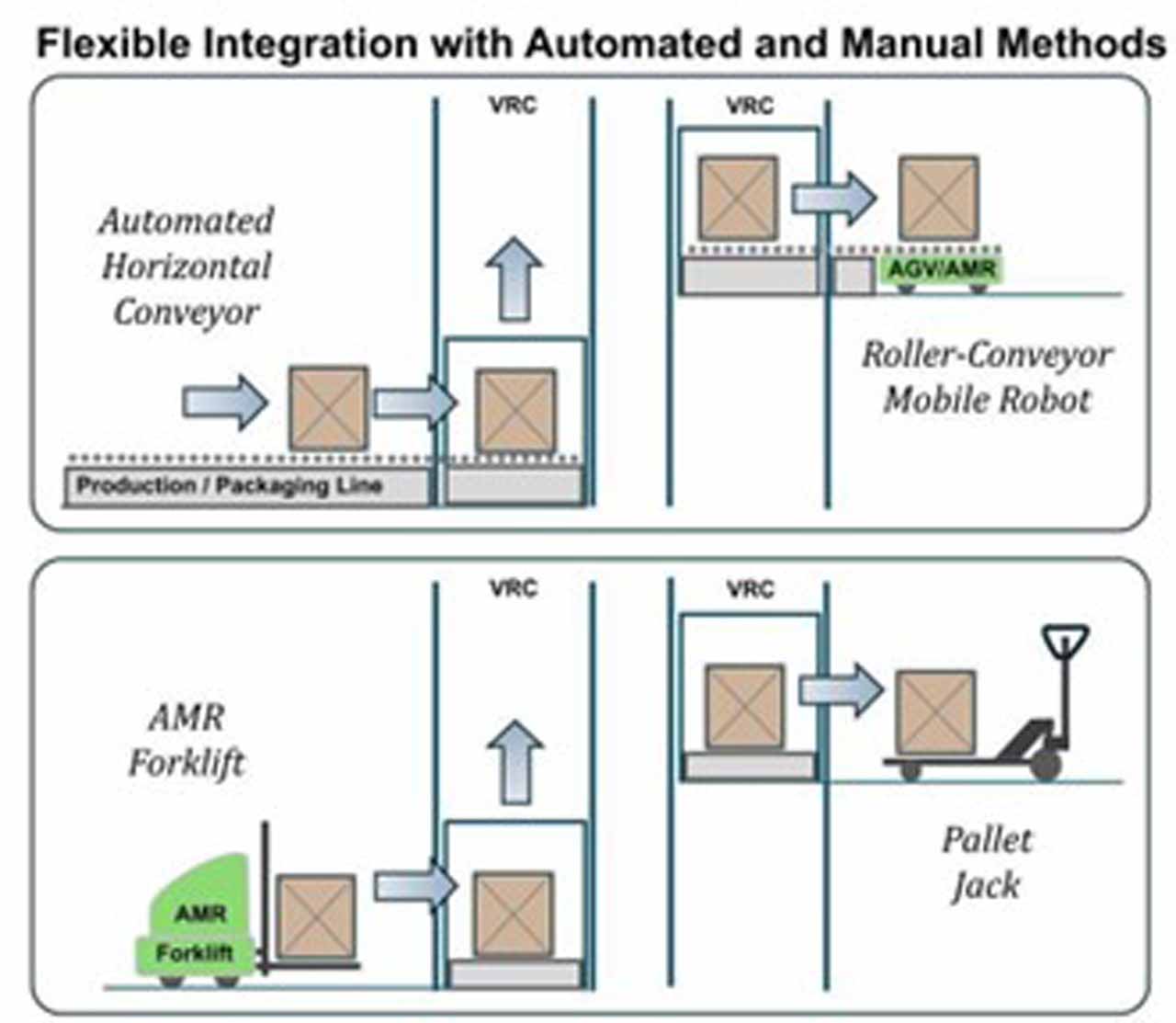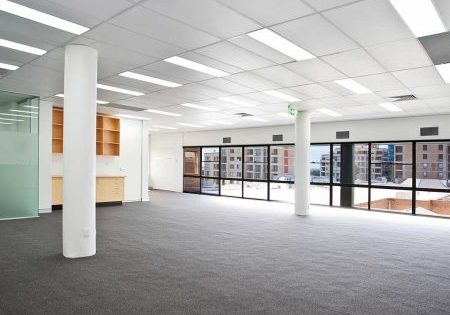Elevating AGVs and AMRs to new levels of efficiency
by Chuck Cobb and Dan Hext
Vertical reciprocating conveyors (VRCs) act as the pivotal link between two major trends in warehouse operations that are dramatically increasing efficiency and profitability:
- Mobile Robots — The widespread adoption of Automated Guided Vehicles (AGVs) and Autonomous Mobile Robots (AMRs) is transforming the horizontal movement of materials across facilities, revolutionizing logistics and material handling processes.
- Vertical Space Utilization — Driven by the pursuit of logistics efficiency, along with escalating real estate costs and last-mile distribution demands, warehouses and production facilities are optimizing “cube space utilization” by expanding upward rather than outward.
VRCs seamlessly integrate horizontal and vertical material-handling processes, facilitating the smooth automated flow of material in three dimensions. These flexible and compact systems can be incorporated into a wide variety of layouts and serve a multitude of different applications.
Combining VRCs with mobile robots and other manual and automated equipment often represents the most efficient, safest and cost-effective solution for accessing taller racking, pick modules, mezzanines and multiple floor levels in virtually any type of warehouse or production environment.
Rapid Adoption of Mobile Robots
AGVs and AMRs are revolutionizing logistics across many industry sectors. In factories, these technological advancements automate material-handling and assembly-line tasks. This not only boosts production rates, but also improves workplace safety by taking over hazardous or repetitive tasks from human workers.
AGVs adhere to predetermined paths, whereas AMRs employ sophisticated sensors and AI for flexible navigation. AGVs, with their lower initial costs, are sometimes preferred by production and packaging operations in obstacle-free routes where predictable timing of material delivery is paramount. Conversely, AMRs offer unparalleled adaptability in dynamic and chaotic settings, making them ideal for large warehouses and distribution centers.
Mobile robots are crucial to the advancement of Industry 4.0, boosting efficiency, flexibility and automation within manufacturing landscapes. Their capacity for autonomous navigation and task execution across diverse scenarios renders them indispensable in the drive toward more intelligent and interconnected factory ecosystems.
In warehouses, the impact of these robots is even more visible and transformative. Several factors are driving the swift adoption:
- E-commerce Growth: As E-commerce continues to experience explosive growth, with next-day-delivery expectations and direct-to-consumer marketing models, AGVs and AMRs are key to meeting demand for quicker order fulfillment and inventory management.
- Complexity of Modern Distribution: Modern warehouses and distribution centers need to rapidly evolve from classic distribution models to an omni-channel model with the agility to pick case packs, fill retail store orders, pick and pack single consumer orders and process customer returns and product refurbishments.
- Labor Shortages and Rising Costs: With ongoing labor shortages, particularly in logistics and manufacturing, AGVs and AMRs offer a solution by automating repetitive tasks.
- Technological Advancements: Enhanced sensors, AI and better batteries have made AGVs and AMRs more adaptable and efficient, capable of performing complex tasks autonomously.
- Safety and Efficiency: Compared to forklifts and manual material-handling equipment, AGVs and AMRs improve workplace safety and operational efficiency, handling hazardous tasks and operating 24/7 with precision.
Vertical Cube Utilization
Two to three decades ago, distribution centers typically featured clear heights of 24 to 32 ft — the vertical space from the floor to the ceiling. Today, driven by the scarcity and increased costs of land — especially near urban centers — and advances in fire protection and material-handling technology, the industry standard for clear heights has shifted to 36 and 40 ft, with demand growing for even taller structures.
The shift toward taller buildings is also fueled by the rapid growth of multi-level facilities specifically designed to optimize last-mile distribution, accommodating increasing demand for faster and more efficient delivery systems in densely populated areas.
Leveraging the “vertical cube” not only maximizes storage, but also streamlines operations, improving material handling, productivity and safety without necessitating horizontal expansion. The utilization of upper levels also frees up prime dock-level real estate for crucial shipping, receiving or re-packaging processes.
Furthermore, the concept of cubic utilization in warehouse and factory design marks a significant shift toward sustainability and energy efficiency. By maximizing cubic space while minimizing the square footage of a building’s exterior envelope, facilities significantly reduce heating, ventilation and air-conditioning costs. This approach not only lowers initial investment in land and construction, but also yields long-term savings in maintenance, operations and even property taxes.
VRCs are regulated as a conveyor under ASME B20.1 — not people-moving elevators — making them less costly to install and maintain than an elevator.
VRCs: Ideal for Automated Material Handling
The symbiotic relationship between these two trends — mobile robots and the utilization of vertical space — mediated through VRC technology, exemplifies how the strategic adoption of advanced automation technologies and space utilization concepts can revolutionize warehousing and manufacturing.
A VRC functions like an elevator, with one fundamental difference: VRCs are intended to move material loads, not people. They are regulated as a conveyor under ASME B20.1 — not people-moving elevators — making them less costly to install and maintain than an elevator.
VRCs have an enclosed platform that prevents loads from falling as they are lifted and lowered. This makes them far safer to operate than forklifts or scissor lifts. VRCs safeguard employees from injuries incurred while transporting items on staircases and deter the misuse of forklifts beyond their safe mast lift height limits.
Flexibility
VRCs are a versatile solution that can be installed next to mezzanines, in existing elevator shafts or through floors. They can also be installed outdoors. VRCs stand out for their exceptional versatility and adaptability, opening a myriad of automated material handling opportunities. They seamlessly integrate with mobile robots and automated conveyor systems, or can be manually loaded and unloaded.
AGVs, AMRs and driverless forklifts can travel with the load on the VRC and continue travel when they arrive at the destination floor. Alternatively, they can efficiently transfer loads onto the VRC at one level, and then another system — whether it’s another AGV, AMR or a different automated or manual material-handling method — can take over at a different level.
Furthermore, VRCs can effortlessly connect with automated horizontal conveyor systems, facilitating the smooth flow of materials to and from production, packaging and shipping operations.
Designed with flexibility at their core, these systems ensure that warehouses and production facilities stay ahead of the curve, easily adapting to new processes and technologies as they evolve.
Seamless Transition
A seamless transition as mobile robots travel on and off the carriage is critical. Proper alignment of the floor and the carriage is necessary to prevent damage to the robots and goods and to avoid operational delays during the transfer between the floor and the VRC platform.
PFlow Industries’ optional, patented DeckLock safety system guarantees smooth and secure transition of goods during loading and unloading operations, providing years of reliable service even under heavy loads and continuous usage. It also prevents unintended carriage descent due to overload or brake malfunction during loading.
Seamless Integration
The integration of AGVs, AMRs and VRCs with warehouse-management systems and fleet-management software represents a significant leap forward in material-handling efficiency, ensuring fluid and cohesive operation within a material-handling ecosystem. As a result, these robots can autonomously transport or collect goods across different facility levels, minimizing the need for human intervention and significantly boosting throughput and operational effectiveness.
Critical to this integration are the features and capabilities that facilitate real-time communication and interoperability among AGVs, AMRs and VRCs. This integration ensures that robots can autonomously and precisely position themselves to either load or unload goods onto the VRCs. The employment of advanced sensors, visual systems and Internet of Things (IoT) technologies enables these machines to share their locations, statuses and the movement of the carriages within the VRCs, thereby streamlining the material-handling process.

Multiple Configuration Options
VRCs’ flexibility and customizability mean they can integrate seamlessly with complex automated material-handling systems and fit into tight spaces. Three basic configurations are available:
- Straddle. In a straddle configuration, the VRC’s carriage is placed between the two guide columns, distributing the weight of the load vertically along the length of both columns. This type of configuration allows for greater lifting capacity and larger carriage platform sizes than a cantilever configuration. The straddle layout allows for C loading (load and unload from the front) and Z loading (load and unload on opposite sides) patterns and is a great option in applications that do not have space constraints and do not require unlimited load height.
- Cantilever. In a cantilever configuration, the VRC’s carriage is supported by two guide columns on one side of the carriage, allowing for more loading and unloading flexibility to maneuver loads, especially in space-constrained areas. This configuration allows easy access from three sides of the VRC and supports three load patterns: a C load pattern (load and unload from the front), a Z load pattern (load and unload from opposite sides) and a 90-degree load pattern (load from the front and unload from the side).
- 4-Post. The 4-post VRC configuration positions the platform within four guide columns to enable maximum lifting capacity and large platform sizes. This configuration is well-suited for applications that require lifting and lowering large, bulky and/or oversized or extremely heavy loads. The configuration of the 4-post system also enables workers to load or unload from any size of the carriage for maximum flexibility.
Comparing Mechanical Versus Hydraulic VRCs for Automation
VRCs are engineered with robust core lifting technology, utilizing either hydraulic or mechanical systems. Hydraulic VRCs are effective for simple, two-level lifting tasks that do not necessitate continuous operation.
For most automated processes, mechanical VRCs are preferable. They are engineered for handling heavy loads, achieving high speeds and enduring continuous cycle operations. Suitable for applications that extend beyond 22 ft in height or require lifting capacities exceeding 6000 lb, mechanical VRCs can transport loads up to 10,000 lb and reach heights surpassing 100 ft.
VRCs can lift material loads weighing as little as 10 lb to loads weighing more than 100,000 lb to two or more floor levels. Unlike other material-lifting equipment, VRCs have an enclosed platform that prevents loads from falling as they are lifted and lowered. This makes them far safer to operate than forklifts or scissor lifts.
Revolutionizing Material-Handling Efficiency
VRCs are fundamentally transforming warehouses and production facilities by extending the potential of mobile robots and facilitating unprecedented efficiency in vertical cube utilization. By enabling the seamless vertical movement of materials, VRCs maximize space in facilities and accelerate the automation process, resulting in faster, safer and more cost-effective material-handling solutions. Consequently, the adoption of VRCs is not just an operational improvement, it’s a strategic upgrade that positions warehouses and production facilities at the forefront of innovation and efficiency.
Get more of Elevator World. Sign up for our free e-newsletter.












